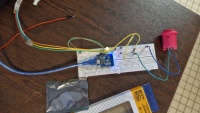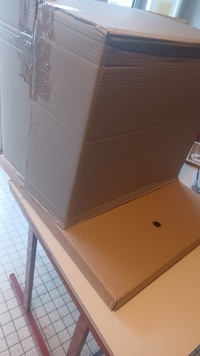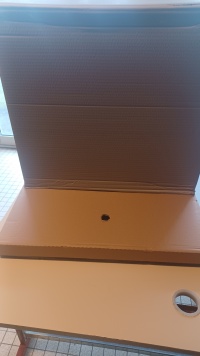ENIB 2024 : CatchTheJackpot
Sommaire
description
Ce projet fonction grâce à une carte Arduino, des LEDs et un bouton.
Une lumière traverse le ruban de gauche à droite et lorsqu'elle est au milieu, il faut appuyer sur le bouton au bon moment pour gagner.
réalisé par :
-Arnaud Genty -Maxime Bintein -Tristan Le Coz
Introduction
éventuelle vidéo
Liste des composants
- Bouton poussoir style Arcade
- Arduino nano
- 2 rubans de LED adressable (85 LEDs pour être exacte)
- Carton
- Bois
- Câbles mini-USB
- Câbles
- écran LCD
- Breadboard
- 2 résistances de 500kΩ
- Buzzer
Outils
- Cutter
- Marqueur noir
- Pistolet à colle
- Scotch
- Fer à souder
- Scie à bois
- Perceuse
- Bibliothèque Arduino FastLed
https://fastled.io/
fichiers à joindre
code, ficher d'impression 3D, de découpe laser ou vinyle, ...
Code :
//Programme fait sur carte STM8266 / WEMOS D1 mini
- include "pitches.h"
- include "FastLED.h" //bibliothèque pour controler le ruban led
- include <Wire.h> //bibliothèque écran
- include <LiquidCrystal_I2C.h> //bibliothèque écran
- define REST 0
- define NUM_LEDS 86
- define NUM_OF_LEDS_BY_LEVEL 17 // nombre de leds par niveau
- define NUM_OF_LEVELS 5 // nombre de niveaux
- define PIN_BTN D3 // Entree du bouton
- define PIN_LEDS D4 // Sortie du ruban led
- define PIN_BUZZER D8 // Signal de sortie buzzer
// -------- INIT VARIABLES --------
LiquidCrystal_I2C lcd(0x27, 16, 2);
CRGB leds[NUM_LEDS]; //Création d'une liste avec chaque led
CRGB randomcolor = CHSV(random(192), 255, 255);
int level = 0; // niveau auquel le joueur est
int delay_level = 30; // délai qui permet de controler la vitesse de déplacement de la led
auto color = CRGB::Blue; // couleur de la led qui se déplace
int score = 0; // score du joueur
const double coef[] = {1,1.5,2,2.5,3}; // coefficient multiplicateur de point par niveau
int last_point[NUM_OF_LEVELS]; // sauvegarde de la derniere led allumée pour la rallumer après flash()
bool game_in_progress = false;
int last_point_visu = 0;
// -------- INIT FONCTIONS --------
int move(); // déplacement de la led void level_up(); // passage de niveau void waiting_start_game(); //affichage d'attente de début du jeu void flash(); // animation de victoire d'un niveau
// -------- PROGRAMME -------- void setup() {
FastLED.addLeds<NEOPIXEL, D4>(leds, NUM_LEDS); // setup du ruban de led sur la sortie PIN_LEDS => 2 pinMode(PIN_BTN, INPUT); // setup du bouton dur l'entrée PIN_BTN => 3 FastLED.setBrightness(50); // setup de la luminosité Serial.begin(9600); // setup moniteur série pour debug int last_point[NUM_OF_LEVELS]; pinMode(PIN_BUZZER, OUTPUT);
// -------- ECRAN -------- lcd.init(); // Initialize I2C LCD module lcd.backlight(); // Turn backlight ON
}
void loop() {
waiting_start_game();
lcd.setCursor(0,0);
lcd.print(" Cliquer ");
lcd.setCursor(0,1);
lcd.print(" pour commencer");
FastLED.clear();
if (digitalRead(PIN_BTN)==LOW){
musique();
game_in_progress = true;
lcd.clear();
lcd.setCursor(0,0);
lcd.print("Partie en cours !");
lcd.setCursor(0,1);
lcd.print("XoXoXoXoXoXoXoXo");
FastLED.clear();
delay(400);
while(game_in_progress){
move();
if (digitalRead(PIN_BTN)==LOW && game_in_progress==true){
level_up();
}
}
}
}
int move(){
// Permet de faire bouger la LED de gauche à droite
for (int i = NUM_OF_LEDS_BY_LEVEL * level; i <= (NUM_OF_LEDS_BY_LEVEL * level + NUM_OF_LEDS_BY_LEVEL - 1); i++){
// -------- DEBUGGING -------- //
/*
Serial.print("val de la led: ");
Serial.print(i);
Serial.print("\n");
*/
if (digitalRead(PIN_BTN)==LOW){ //Stock des scores LEDs 1 -> 9 -> 1
int center = abs(i - (NUM_OF_LEDS_BY_LEVEL * level + NUM_OF_LEDS_BY_LEVEL / 2));
if (center <= NUM_OF_LEDS_BY_LEVEL/2) {
last_point[level] = NUM_OF_LEDS_BY_LEVEL/2 - center + 1; // Les points augmentent jusqu'à 9
} else {
last_point[level] = 0; // À partir de la position 9, les points diminuent
}
// if(i<(1/2*NUM_OF_LEDS_BY_LEVEL)){
// last_point[level] = i;
// }
// else{
// for(int degr = 1; degr<NUM_OF_LEDS_BY_LEVEL; degr++)
// last_point[level] = (i - degr);
// }
int last_point_visu = i-1;
return i-1;
// -------- DEBUGGING -------- //
/*
Serial.print("last_point_visu");
Serial.print(last_point_visu);
for(int z=0; z<NUM_OF_LEVELS; z++){
Serial.print(last_point[z]);
Serial.print("\n");
}
*/
}
//Eteins les LEDs derrière la LED mouvante
leds[i - 1] = CRGB::Black;
delay(3);
leds[level * NUM_OF_LEDS_BY_LEVEL + NUM_OF_LEDS_BY_LEVEL / 2] = CRGB::Yellow;
leds[i] = color;
FastLED.show();
delay(delay_level);
}
leds[NUM_OF_LEDS_BY_LEVEL * level + 20] = CRGB::Black;
FastLED.show();
delay(delay_level);
for (int i = NUM_OF_LEDS_BY_LEVEL * level + NUM_OF_LEDS_BY_LEVEL - 1; i >= NUM_OF_LEDS_BY_LEVEL * level ; i--)
{
// -------- DEBUGGING -------- //
/*
Serial.print("val de la led: ");
Serial.print(i);
Serial.print("\n");
*/
if (digitalRead(PIN_BTN)==LOW){ //Stock des scores LEDs 1 -> 9 -> 1
int center = abs(i - (NUM_OF_LEDS_BY_LEVEL * level + NUM_OF_LEDS_BY_LEVEL / 2));
if (center <= NUM_OF_LEDS_BY_LEVEL/2) {
last_point[level] = NUM_OF_LEDS_BY_LEVEL/2 - center + 1; // Les points augmentent jusqu'à 9
} else {
last_point[level] = 0; // À partir de la position 9, les points diminuent
}
// if(i<(1/2*NUM_OF_LEDS_BY_LEVEL)){
// last_point[level] = i;
// }
// else{
// for(int degr = 1; degr<NUM_OF_LEDS_BY_LEVEL; degr++)
// last_point[level] = (i - degr);
// }
int last_point_visu = i+1;
return i+1;
// -------- DEBUGGING -------- //
/*
Serial.print("last_point_visu");
Serial.print(last_point_visu);
for(int z=0; z<NUM_OF_LEVELS; z++){
Serial.print(last_point[z]);
Serial.print("\n");
}
*/
}
//Eteins les LEDs derrière la LED mouvante
leds[i + 1] = CRGB::Black;
delay(3);
leds[level * NUM_OF_LEDS_BY_LEVEL + NUM_OF_LEDS_BY_LEVEL / 2] = CRGB::Yellow;
leds[i] = color;
FastLED.show();
delay(delay_level);
}
leds[NUM_OF_LEDS_BY_LEVEL] = CRGB::Black;
FastLED.show();
delay(delay_level);
return 0;
}
void flash() // fonction de décoration qui fait clignoter les leds en blanc avant le passage de niveau {
for (int cpt = 0; cpt < 4; cpt++)
{
for (int i = NUM_OF_LEDS_BY_LEVEL * level; i <= (NUM_OF_LEDS_BY_LEVEL * level + NUM_OF_LEDS_BY_LEVEL - 1); i++) // On met toute les leds du niveau en blanc
{
leds[i] = CRGB::Green;
}
FastLED.show();
delay(100);
for (int i = NUM_OF_LEDS_BY_LEVEL * level; i <= (NUM_OF_LEDS_BY_LEVEL * level + NUM_OF_LEDS_BY_LEVEL - 1); i++) // On éteint toutes les leds du niveau
{
leds[i] = CRGB::Black;
}
FastLED.show();
delay(100);
}
leds[last_point_visu] = CRGB::Purple;
}
void level_up() // changement de niveau {
flash(); // animation level++; // incrémentation de la variable niveau delay_level -= 4; // le jeu devient de plus en plus rapide
if (level >= NUM_OF_LEVELS) // fin du jeu
{
compute_score(); //Calcul le score
show_score(); //Affiche le score sur un écran à crystaux liquides
//Remise des valeurs pas défaut
level = 0;
score = 0;
delay_level = 30;
game_in_progress = false;
for(int w=0; w<NUM_OF_LEVELS;w++){
last_point[w] = 0;
}
}
}
void waiting_start_game(){
// Allume toutes les LEDs en bleu avant de faire commencer la partie
for (int w = 0; w < NUM_LEDS; w++){
leds[w] = CRGB::Blue;
}
FastLED.show();
}
int compute_score(){
// Récupere les élements du tableau last_point et les additionnes
for (int i = 0; i<NUM_OF_LEVELS; i++){
if (i > 2) {
// Pour les niveaux 4 et 5, le score est diviser par deux
score += last_point[i] / 2;
} else {
score += last_point[i];
}
}
// -------- DEBUGGING -------- //
/*
Serial.print("Score : ");
Serial.println(score);
*/
return score;
}
int show_score(){
lcd.clear();
lcd.setCursor(0,0);
lcd.print(" Score : ");
lcd.print(score);
lcd.setCursor(0,1);
lcd.print(" Bien joue !!"); // Je ne sais pas comment mettre des caractères speciaux (hors ASCII 128)
delay(5000);
lcd.clear();
return 0;
}
// ----- MUSIQUE ----- //
int melody[] = {
//Based on the arrangement at https://www.flutetunes.com/tunes.php?id=169 NOTE_AS4,-2, NOTE_F4,8, NOTE_F4,8, NOTE_AS4,8,//1 NOTE_GS4,16, NOTE_FS4,16, NOTE_GS4,-2, NOTE_AS4,-2, NOTE_FS4,8, NOTE_FS4,8, NOTE_AS4,8, NOTE_A4,16, NOTE_G4,16, NOTE_A4,-2, REST,1,
NOTE_AS4,4, NOTE_F4,-4, NOTE_AS4,8, NOTE_AS4,16, NOTE_C5,16, NOTE_D5,16, NOTE_DS5,16,//7 NOTE_F5,2, NOTE_F5,8, NOTE_F5,8, NOTE_F5,8, NOTE_FS5,16, NOTE_GS5,16, NOTE_AS5,-2, NOTE_AS5,8, NOTE_AS5,8, NOTE_GS5,8, NOTE_FS5,16, NOTE_GS5,-8, NOTE_FS5,16, NOTE_F5,2, NOTE_F5,4,
NOTE_DS5,-8, NOTE_F5,16, NOTE_FS5,2, NOTE_F5,8, NOTE_DS5,8, //11 NOTE_CS5,-8, NOTE_DS5,16, NOTE_F5,2, NOTE_DS5,8, NOTE_CS5,8, NOTE_C5,-8, NOTE_D5,16, NOTE_E5,2, NOTE_G5,8, NOTE_F5,16, NOTE_F4,16, NOTE_F4,16, NOTE_F4,16,NOTE_F4,16,NOTE_F4,16,NOTE_F4,16,NOTE_F4,16,NOTE_F4,8, NOTE_F4,16,NOTE_F4,8,
NOTE_AS4,4, NOTE_F4,-4, NOTE_AS4,8, NOTE_AS4,16, NOTE_C5,16, NOTE_D5,16, NOTE_DS5,16,//15 NOTE_F5,2, NOTE_F5,8, NOTE_F5,8, NOTE_F5,8, NOTE_FS5,16, NOTE_GS5,16, NOTE_AS5,-2, NOTE_CS6,4, NOTE_C6,4, NOTE_A5,2, NOTE_F5,4, NOTE_FS5,-2, NOTE_AS5,4, NOTE_A5,4, NOTE_F5,2, NOTE_F5,4,
NOTE_FS5,-2, NOTE_AS5,4, NOTE_A5,4, NOTE_F5,2, NOTE_D5,4, NOTE_DS5,-2, NOTE_FS5,4, NOTE_F5,4, NOTE_CS5,2, NOTE_AS4,4, NOTE_C5,-8, NOTE_D5,16, NOTE_E5,2, NOTE_G5,8, NOTE_F5,16, NOTE_F4,16, NOTE_F4,16, NOTE_F4,16,NOTE_F4,16,NOTE_F4,16,NOTE_F4,16,NOTE_F4,16,NOTE_F4,8, NOTE_F4,16,NOTE_F4,8
};
void musique(){
int tempo = 60;
// sizeof gives the number of bytes, each int value is composed of two bytes (16 bits)
// there are two values per note (pitch and duration), so for each note there are four bytes
int notes = sizeof(melody) / sizeof(melody[0]) / 2;
// this calculates the duration of a whole note in ms
int wholenote = (60000 * 2) / tempo;
int divider = 0, noteDuration = 0;
// iterate over the notes of the melody.
// Remember, the array is twice the number of notes (notes + durations)
for (int thisNote = 0; thisNote < notes * 2; thisNote = thisNote + 2) {
// calculates the duration of each note
divider = melody[thisNote + 1];
if (divider > 0) {
// regular note, just proceed
noteDuration = (wholenote) / divider;
} else if (divider < 0) {
// dotted notes are represented with negative durations!!
noteDuration = (wholenote) / abs(divider);
noteDuration *= 1.5; // increases the duration in half for dotted notes
}
// we only play the note for 90% of the duration, leaving 10% as a pause tone(PIN_BUZZER, melody[thisNote], noteDuration*0.9);
// Wait for the specief duration before playing the next note. delay(noteDuration); // stop the waveform generation before the next note. noTone(PIN_BUZZER); }
}
étapes de fabrication
étape 1: câbler et souder
câbler les fils entre les leds, la carte arduino et le bouton puis souder les fils si nécessaire et enfin téléverser le programme dans la carte si nécessaire.
étape 2: le support
réaliser le prototype en carton
étape 3 : support en bois
On réalise en suite le support en bois.
Grâce au prototype en carton on dessine le support en bois puis on reporte les mesures sur des plaques en bois pour ensuite les découper.
Une fois les différentes parties du support faites on les assemble.
troubleshouting
quelles sont difficultés, les problèmes, quelles sont les solutions, les trucs et astuces pour que ça marche ?
1er problème : le programme ne marchait pas car la LED était montée à l'envers
On a mit la led ans le bon sens puis on a adapté le programme.
2ème problème : adapter la taille du support qui était d'abord trop grand
On a utilisé le support en carton pour créer un support en bois plus petit.



